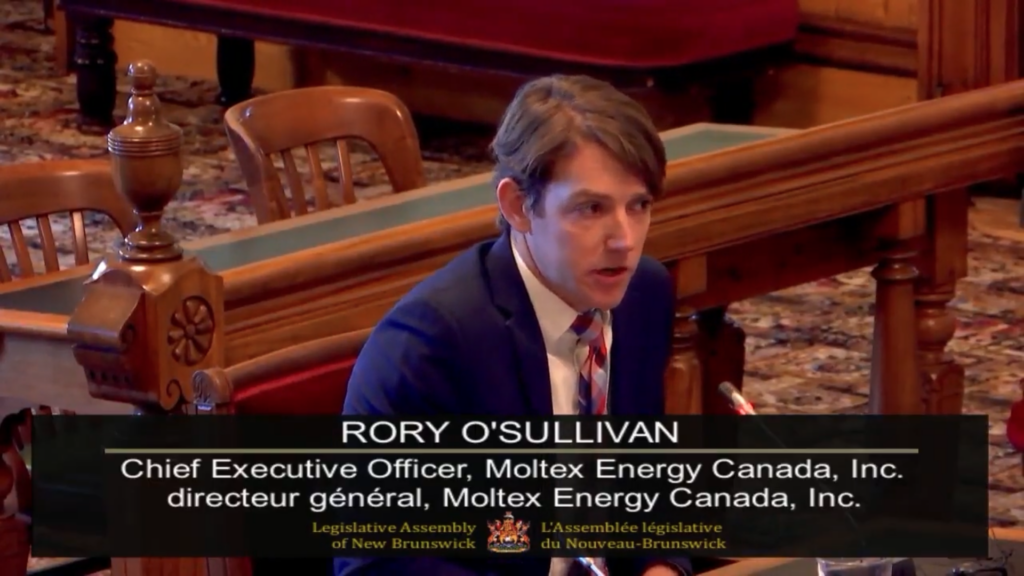Canadian reactors that “recycle” plutonium would create more problems than they solve
By Jungmin Kang, M.V. Ramana | May 25, 2023
 The Aircraft Reactor Experiment at Oak Ridge National Laboratory in 1954, the first reactor to use circulating molten salt fuel. Canadian company Moltex Energy's proposed molten salt reactor and spent fuel conversion process would create more waste and increase proliferation risks, according to Jungmin Kang and M.V. Ramana. (Photo credit: US government / ORNL, via Flickr)
The Aircraft Reactor Experiment at Oak Ridge National Laboratory in 1954, the first reactor to use circulating molten salt fuel. Canadian company Moltex Energy's proposed molten salt reactor and spent fuel conversion process would create more waste and increase proliferation risks, according to Jungmin Kang and M.V. Ramana. (Photo credit: US government / ORNL, via Flickr)
In 2021, nine US nonproliferation experts sent an open letter to Canada’s Prime Minister Justin Trudeau. In their letter, the experts expressed their concern that the Canadian government was actually increasing the risk of nuclear weapons proliferation by funding reactors that are fueled with plutonium. Earlier that year, the Federal Government had provided 50.5 million Canadian dollars to Moltex Energy, a company exploring a nuclear reactor design fueled with plutonium. The linkage to nuclear weapons proliferation has also led several civil society groups to urge the Canadian government to ban plutonium reprocessing.
Much of the concern so far has been on Canada setting a poor example by sending a “dangerous signal to other countries that it is OK to for them to extract plutonium for commercial use.” But Moltex plans to export its reactors to other countries raise a different concern. Even if a country importing such a reactor does not start a commercial program to extract plutonium, it would still have a relatively easy access to plutonium in the fuel that the reactor relies on to operate. Below we provide a rough estimate of the quantities of plutonium involved—and their potential impact on nuclear weapons proliferation—to help explain the magnitude of the problem. But there is more. By separating multiple radionuclides from the solid spent fuel and channeling it into waste streams, Moltex reactors will only make the nuclear waste problem worse.
Moltex’s technological claims. Moltex established its Canadian headquarters in the province of New Brunswick after it received an infusion of 5 million Canadian dollars from the provincial government. The company offers two products: a molten salt reactor and a proprietary chemical process that Moltex terms “waste to stable salts” technology. Moltex claims that, by using its chemical process, it can “convert” spent fuel from Canada’s deuterium uranium nuclear reactors (CANDUs) into new fuel that can be used in its reactor design. Moltex essentially claims it can “reduce waste.” In light of the problematic history associated with molten salt reactors, Moltex’s proposed reactors, and especially the chemical process needed to produce fuel, deserve more scrutiny. These will have serious implications for nuclear policy.
In its response to the open letter from the US nonproliferation experts, Moltex dismissed the ability of outsiders to comment, arguing that experts “are not aware of [its proprietary] process as only high-level details are made public.” Moltex has been indeed sparse in what it shared publicly about its technologies. Still, there is much one can surmise from earlier experiences with the processing of spent fuel and from basic science. With some simple calculations based on these high-level details provided by Moltex so far—and taking those at face value, i.e., without evaluating the feasibility of the design or their plans—we show that there is reason to be concerned about the amounts of plutonium that will be used in the reactor.
In a February 2021 presentation to the US National Academies of Sciences, Engineering, and Medicine committee on fuel cycles and waste aspects of advanced nuclear reactors, Moltex’s Chief Executive Officer, Rory O’Sullivan, described how an electric current is used to convert the oxide form of uranium and plutonium into the metallic (alloy) form of these elements and separate the fission products in the spent fuel from the uranium and plutonium and some other heavier elements. (Although there are some differences, Moltex’s chemical process seems close to the much better studied pyroprocessing process.) O’Sullivan also described the chemical composition of Moltex’s fresh fuel as being 45 percent potassium chloride, 23.9 percent uranium chloride, and 22.2 percent plutonium chloride, with the remaining 8.9 percent comprising unspecified actinides and lanthanides.

How much plutonium? To understand the quantities involved and their significance for nuclear proliferation, we used a standard computer code called Origen-2 (which stands for Oak Ridge Isotope GENeration) to compute the amounts of the different radioactive elements in CANDU spent fuel, which typically has a burnup of around 7,000 megawatt-days per ton (MWd/t). The burnup is the amount of thermal energy produced per unit of heavy metal (i.e., uranium plus plutonium) measured in tons. For comparison, typical burnups for light water reactor fuel are in the range of 40,000 to 50,000 MWd/t. According to the International Atomic Energy Agency (IAEA)’s biennial publication on small modular reactors from 2022, which is based on information supplied by companies and organizations developing reactors, the burnup of the Moltex reactor is designed to be around 100,000 MWd/t.
Our Origen-2 calculations showed that CANDU spent fuel will be mostly composed of uranium (98.8 percent) that did not fission when it was inside the reactor. Plutonium constitutes around 0.42 percent of the total mass of the spent fuel, and fission products and actinides comprise the rest. The chemical process that Moltex is proposing aims at extracting the necessary materials for producing fresh fuel for the Moltex reactor from the fission products and the extra uranium.
The Moltex reactor is designed to produce 750 megawatts of heat, which, if it operates 90 percent of the time at full power, would produce 246,375 MWd of heat annually. Considering the IAEA’s specified burnup of 100,000 MWd/t, the heat generated by one Moltex reactor would need about 2.46 tons of fuel per year. Using the distribution of 22.9 percent of plutonium chloride and 23.9 percent uranium chloride, and using the ratio of the atomic masses of chlorine and plutonium, one can conclude that the reactor would need about 392 kg of plutonium as fuel every year. In his 2021 presentation, O’Sullivan also mentioned that the average fuel assembly resides for 6.3 years in the reactor. This means that the initial loading for the reactor to start operating would require roughly 2.4 tons of plutonium.
According to our Origen-2 calculations, the CANDU spent fuel consists of roughly 0.42 percent plutonium. Exactly how much of this plutonium can be recovered using the Moltex chemical process cannot be known before the facility is built and operating. But one can be sure that at least some plutonium will be left behind in the waste produced while chemically processing spent fuel. When questioned at the National Academies presentation about whether the process would result in all the plutonium being separated (“zero actinides”), O’Sullivan responded that “there’s no such thing as zero” in these processes. For the purposes of our calculations, we assumed an already ambitious efficiency of 99 percent. (Whether the actual efficiency would be 99 percent or 98 percent is not very relevant for the calculations about proliferation, but it is extremely important for the assessments about the waste streams generated and how they must be dealt with.)
To obtain the 2.4 tons of plutonium required in the startup fuel for a single 300 megawatt-electric (MWe) Moltex reactor, then, around 577 tons of CANDU spent fuel would have to be processed. A further 94 tons of CANDU spent fuel must go through Moltex’s waste-to-stable-salts chemical process to produce the necessary fuel for each year of operations. For perspective, the Canada’s Nuclear Waste Management Organization estimates that, as of June 2022, there were roughly 61,000 tons of spent fuel in Canada. Of these, around 3,200 tons of spent fuel are stored at the Point Lepreau site in New Brunswick, where Moltex plans to build its first reactor and chemical processing facility.
Proliferation risks. Plutonium can be used not just to fuel reactors but also to make nuclear weapons. The International Atomic Energy Agency defines a “significant quantity” as the approximate amount of fissile material “for which the possibility of manufacturing a nuclear explosive device cannot be excluded.” For plutonium, the significant quantity is 8 kilograms, including losses during production. This figure, however, over-estimates the required quantity of material to make a nuclear weapon; sophisticated nuclear weapon designs require far smaller quantities of plutonium. Even assuming each weapon uses 8 kilograms of plutonium, the amount of plutonium in the core of a new Moltex reactor would suffice to make around 300 nuclear weapons.
Moltex argues that the plutonium used in its reactors is not pure and therefore is not directly usable in weapons. But that argument misses the point. Compared to the plutonium still contained in CANDU spent fuel, the plutonium in the fresh fuel intended to be used in Moltex’s reactors would be far more accessible because it is no longer mixed with the intensely radioactive fission products created when the fuel is irradiated in the reactor. Therefore, converting plutonium to a form suitable for nuclear weapons is much easier if it arrives packaged as fresh fuel: One would not need a full-scale reprocessing plant with thick shielding and remote processing that would otherwise be required to handle the much more radioactive spent fuel to avoid high radiation doses to workers.
Moltex’s proposed technology has not yet been evaluated by the International Atomic Energy Agency for how well it can be safeguarded; nor is it possible to evaluate how well the technology can be safeguarded in advance of a final design. But there is good reason to think that a determined country—one that might not play by the rules set by the IAEA—might find a way to divert some plutonium from Moltex’s chemical process to use it in nuclear weapons.
Diversion has been a long-standing concern with pyroprocessing, which is closely related to what Moltex is proposing. This is because the process produces plutonium that is not mixed with radioactive fission products and therefore can be more easily diverted. As a US State Department official put it in 2011, pyroprocessing “is dangerous from a proliferation point of view.” Former IAEA official Olli Heinonen has described some of the problems—including the fact that attempts at safeguards of pyroprocessing plants have only been done at laboratory scale and the highly corrosive environment in which instruments for verification have to operate—make them more likely to malfunction or fail. All of these dangers will also apply to the process proposed by Moltex.
The proliferation risks should be of concern to policy makers because Moltex hopes to export its reactors to multiple countries. In a second presentation to the National Academies from February 2022, O’Sullivan showed a world map where there were Moltex reactors in 22 countries—including countries like India, Pakistan, Russia, and China that already have nuclear weapons, as well as countries like Argentina and South Korea that have sometimes explored acquiring nuclear weapons. Or so is the company’s wish: There is little evidence so far of demand for Moltex’s reactors from these purported customer countries. Yet, if such export objectives were to ever be achieved, this would mean that several countries might suddenly get access to large quantities of plutonium, in a chemical and physical state where they can feed a nuclear weapon program relatively easily.
If a country with no nuclear weapons were to decide to develop or acquire a Moltex reactor, political and military planners in other countries should assume that such a country would then have the possibility to turn this capability into an actual, even if clandestine, nuclear weapons program of its own.

Less, or more, radioactive waste? O’Sullivan has also reportedly touted Moltex’s alleged ability “to affordably extract the most radioactive parts of the existing nuclear waste from the Point Lepreau Generating Station” and “make the remainder less radioactive for a much shorter amount of time.”
Leaving aside the claim about affordability—because no one, not even Moltex executives, can know for sure how much Moltex’s chemical process will ultimately cost, given that it is still under development—the claim about extracting the “most radioactive parts” does not make much sense. Plutonium and other higher actinides (defined as isotopes having an atomic number of 93 or greater) that are being extracted have long radioactive half-lives. That means that at each instant fewer of those nuclei would be decaying in comparison with the much more active, short-lived fission products.
The key claim made by Moltex, therefore, is that the waste from its reactors would indeed be “radioactive for a much shorter amount of time.” In an earlier interview, O’Sullivan was more explicit, saying Moltex’s “end product is only radioactive for several hundred years, which is significantly shorter than for conventional waste that is radioactive for around 300,000 years.” But the Moltex chemical process will also generate waste streams in addition to the plutonium fuel for its reactors, which, at the end of the process, will contain lots of elements that will be radioactive for much longer than several hundred years.
In a 2017 company document, Moltex identified three radioactive waste streams from this process, besides the fuel for the reactor: “higher actinide depleted uranium/iron”, “noble gas fission products” (which are vented into the atmosphere), and “spent calcium chloride based electrolyte containing the majority of the fission products.” (Just for comparison, a study from the Idaho National Laboratory of the waste streams produced from pyroprocessing lists at least six radioactive waste streams.) The Moltex list seems incomplete, however. For example, it does not mention the radioactive cladding (the thin-walled metal tubes that form the outer layer of nuclear fuel rods) that has to be removed from the spent fuel before it can be processed. In his February 2021 presentation to the National Academies, O’Sullivan did acknowledge in fact that the cladding might end up as a waste stream, even though he did talk about reusing the zirconium (an alloy widely used in the nuclear industry as fuel rod cladding).
In the case of Moltex, at least two of the three waste streams (the higher actinide depleted uranium/iron and the spent calcium chloride-based electrolyte) will contain long-lived radioactive elements. What Moltex terms “higher actinide depleted,” for example, will continue to have trace quantities of plutonium and other higher actinides. The exact amount will depend on the efficiency of extraction, which, as discussed, cannot be known a priori.
The more difficult challenge derives from the fact that higher actinides are not the only long-lived radioactive elements that the Moltex chemical process will generate. Many fission products, which are contained in the spent fuel from reactors, have very long half-lives, and these are important contributors to the long-term (i.e., tens to hundreds of thousands of years) radioactive dose in the vicinity of future deep geological repositories where the waste is supposed to be permanently stored. For instance, a 2017 technical report from Canada’s Nuclear Waste Management Organization lists technetium 99, cesium 135, and iodine 129 among the key long-lived fission products in CANDU spent fuel that are still present in significant quantities 10,000 years after the discharge from the reactors. The activation product, carbon 14, is also a significant contributor to the radiation dose.
These radionuclides are currently within solid CANDU spent fuel, stored at reactor sites. If these spent fuel materials were to be used to produce fuel for Moltex reactors, their radionuclides would be separated and flow into either one of the waste streams—or into the atmosphere. The long radioactive lifetimes and high activity levels even a thousand years into the future means that these materials cannot be considered as being “radioactive only for several hundred years.”
Now we can quantify the waste produced by Moltex’s chemical process.
Producing the 2.4 tons of plutonium fuel needed for the initial loading of a single 300 MWe Moltex reactor would result in also generating waste forms that, a thousand years into the future, would still contain 113 teraBecquerels (TBq, or trillion Becquerels; one Becquerel corresponds to one nucleus disintegrating every second) of technetium 99 (half-life of 211,000 years), 225 gigaBecquerels (GBq, or billion Becquerels) of iodine 129 (half-life of 15.7 million years), 825 GBq of cesium 135 (half-life of 2.3 million years), and 14.9 TBq of carbon 14 (half-life of 5,700 years). Annually, the production of fuel for one Moltex reactor would generate about 18.4 TBq of technetium 99, 37 GBq of iodine 129, 134 GBq of cesium 135, and 2.4 TBq of carbon 14. Of this carbon 14, a portion may be released to the atmosphere, contributing to an increased radiation dose to the world’s population at large.
All these radioactive wastes would be produced during the production of fuel for proposed Moltex reactors from the chemical processing of CANDU spent fuel. These do not even include other radioactive materials that would be produced during the operations of Moltex’s proposed reactors. But the assessment of the additional waste from these reactors would be even more complicated because it would be mixed with corrosive salts, prompting experts to question “which, if any, disposal environment could accommodate this high-level waste.”
All this provides sufficient evidence to ask whether Moltex’s chemical processing of CANDU spent fuel would ultimately improve or worsen the waste problem of CANDU reactors. We would argue that Canada would be better off to leave spent fuel in its current form as solid CANDU fuel bundles until there is a technically sound and socially acceptable path forward for these radioactive wastes in Canada. That path is still unclear.
Making bad problems worse. Moltex’s proposal to process CANDU spent fuel to produce fresh fuel for the nuclear reactor it is designing would turn what is currently a more geographically limited problem—of ensuring that the spent fuel is safely stored—into a more complex challenge of managing multiple and chemically diverse radioactive waste streams, which would remain hazardous to human beings for several thousands of years. Historically, radioactive waste streams from reprocessing plants in France and the United Kingdom has led to contamination of the surrounding seas. Should Moltex proceed with its plans in New Brunswick, such contamination would extend to the Bay of Fundy, an area recognized by the UN Educational, Scientific and Cultural Organization (UNESCO) for its rich biodiversity.
Meanwhile, Moltex’s efforts at processing spent fuel will create a significant new stream of plutonium, albeit not in a pure form, which would make the problem of nuclear proliferation worse. In addition to the chemical process itself, the possibility of diversion of fresh fuel that has large quantities and high concentrations of plutonium would make the process particularly concerning. Such diversion risk has been a long-standing concern, and was the reason in the first place for the worldwide effort to reduce the use of highly enriched uranium (another weapons usable material of concern), in civilian research reactors.
Moltex’s proposed technology would inherently increase the amount of material that could potentially be used in nuclear weapons and exacerbate the hitherto unsolved problem of radioactive waste. The Canadian government should reevaluate its funding and support for such a technology.
Together, we make the world safer.
The Bulletin elevates expert voices above the noise. But as an independent nonprofit organization, our operations depend on the support of readers like you. Help us continue to deliver quality journalism that holds leaders accountable. Your support of our work at any level is important. In return, we promise our coverage will be understandable, influential, vigilant, solution-oriented, and fair-minded. Together we can make a difference.
Keywords: CANDU, Canada, advanced reactors, molten salt reactor, moltex, nuclear nonproliferation, plutonium, pyroprocessing, reprocessing, safeguards, spent nuclear fuel
Topics: Nuclear Energy
















“In a second presentation to the National Academies from February 2022, O’Sullivan showed a world map where there were Moltex reactors in 22 countries—including countries like India, Pakistan, Russia, and China that already have nuclear weapons, as well as countries like Argentina and South Korea that have sometimes explored acquiring nuclear weapons.” The map was showing potential markets, nothing more. You wording makes it sound like some evil plot: “showed a world map where there were Moltex reactors in 22 countries.” They also highlighted potential markets in Britain, France, Germany, Finland, Sweden, and the USA. Any export would an export… Read more »
Not a word that I saw about whether CANDU is a thermal or fast reactor; it is thermal. They would make much better progress if they switched their thinking to fast reactors; those that use a non-moderated (fast) spectrum of neutrons to induce fission. These use as fuel most of the transuranic actinides thereby reducing the highly radioactive waste while producing more energy.
Great reporting, thank you!
Moltex is yet another step in Progress that we don’t need.
What part of a reactor is what this planet looks like?
This is an utterly disingenuous article, and precisely what one would expect of authors that are not scientists, much less reactor physicists. The result is something that is utterly scientifically illiterate. Such complete ignorance is astounding. For a start, they seem unaware that not all plutonium isotopes are the same. The plutonium involved in the CANDU waste stream is mostly Pu-240, not Pu-239 (ie., reactor grade, not weapons grade). You don’t need plutonium for the initial start-up load; it’s added later as the WATTS fuel stream comes in. Initial load is uranium. The authors also appear ignorant that the longer… Read more »
This is a very ill-informed presentation, as the plutonium generated in nuclear reactors is unsuitable for nuclear weapons. This plutonium is effectively contaminated for the purposes of making nuclear weapons, which is why spent fuel is NEVER used to make nuclear weapons. Plutonium from nuclear weapons is made by production reactors controlled by the military. Reactors are designed to be optimized to produce electricity or to make plutonium, it is a binary trade-off, and no reactor can do both efficiently. It has been tried. In effect, there is no linkage between making nuclear weapons and nuclear power plants, in fact… Read more »